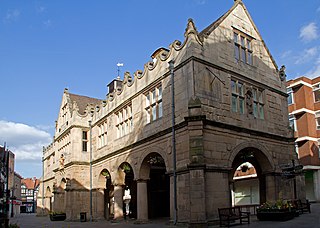
The Corn Exchange is an events and concert venue located on Wheeler Street in Cambridge, Cambridgeshire, England. The structure, which was commissioned as a corn exchange, is a Grade II listed building.

The Hazlitt Theatre and Exchange Studio, also known as the Hazlitt Arts Centre, is a theatre complex in Earl Street in Maidstone, Kent, England. The oldest part of the complex, which is now used as a shopping complex on the ground floor, and as a theatre venue known as the "Exchange Studio" on the first floor, is a Grade II listed building.

The Old Market Hall is an Elizabethan building situated in the town centre of Shrewsbury, the county town of Shropshire, England. It is a Grade I listed building.

The Corn Exchange is an events and concert venue located on St Paul's Square in the Castle area of Bedford, Bedfordshire, England. The structure, which was commissioned as a corn exchange, is a Grade II listed building.

Corn exchanges are distinct buildings which were originally created as a venue for corn merchants to meet and arrange pricing with farmers for the sale of wheat, barley, and other corn crops. The word "corn" in British English denotes all cereal grains, such as wheat and barley. With the repeal of the Corn Laws in 1846, a large number of corn exchanges were built in England, particularly in the corn-growing areas of Eastern England.

Sandbach Town Hall is a municipal building in the High Street in Sandbach, Cheshire, England. The structure, which is the meeting place of Sandbach Town Council, is a Grade II listed building.

The Old Town Hall is a municipal building in the Market Square, Leighton Buzzard, Bedfordshire, England. The town hall, which is currently used as a restaurant, is a Grade II listed building.

Redesdale Hall, also referred to as Moreton-in-Marsh Town Hall, is a municipal building in the High Street, Moreton-in-Marsh, Gloucestershire, England. The building, which is used as an events venue, is a Grade II listed building.

Tetbury Market House, also known as Tetbury Town Hall, is a municipal building in the Market Place, Tetbury, Gloucestershire, England. The building, which was used both as a market house and as a town hall until the late 19th century, is a Grade I listed building.

Rugeley Town Hall was a municipal building in the Market Square in Rugeley, Staffordshire, England. The building, which was the headquarters of Rugeley Urban District Council, was demolished in 1978.

The Corn Exchange is a commercial building in the St Catherine Street, Cupar, Fife, Scotland. The structure, which is now used as a community events venue, is a Category B listed building.

The Corn Exchange is a commercial building in the Market Place, Fakenham, Norfolk, England. The structure, which is currently used as a cinema, is a Grade II listed building.

The Corn Exchange is a commercial building in Thurland Street, Nottingham, Nottinghamshire, England. The structure, which is now used as an events venue, is a Grade II listed building.

The Corn Hall is a commercial building in the Market Place, Swaffham, Norfolk, England. The structure, which is used as offices and as a coffee house, is a Grade II listed building.

The Corn Exchange is a commercial building in the Market Place, Kettering, Northamptonshire, England. The structure, which was used as a cinema for much of the 20th century, currently accommodates a restaurant.

Westgate Hall is a commercial building in Westgate, Grantham, Lincolnshire, England. The structure, which was last used as a nightclub, is a Grade II listed building.

The Corn Exchange is a commercial building in Broad Street, Stamford, Lincolnshire, England. The structure was refurbished between 2001 and 2008 and is now used as a theatre.

The Corn Exchange is a commercial building in Sincil Street, Lincoln, Lincolnshire, England. The structure, which is now used as a restaurant and shops, is a Grade II listed building.

The Corn Exchange is a commercial building in the High Street in Ross-on-Wye, Herefordshire, England. The structure, which is now used as a bookshop and as the offices of Ross-on-Wye Town Council, is a Grade II listed building.

The Corn Exchange and Fire Station is a commercial complex in George Street in Oxford, Oxfordshire, England. The structure is now occupied by an arts charity, Arts at the Old Fire Station, and a homelessness charity, Crisis Skylight Oxford.





















